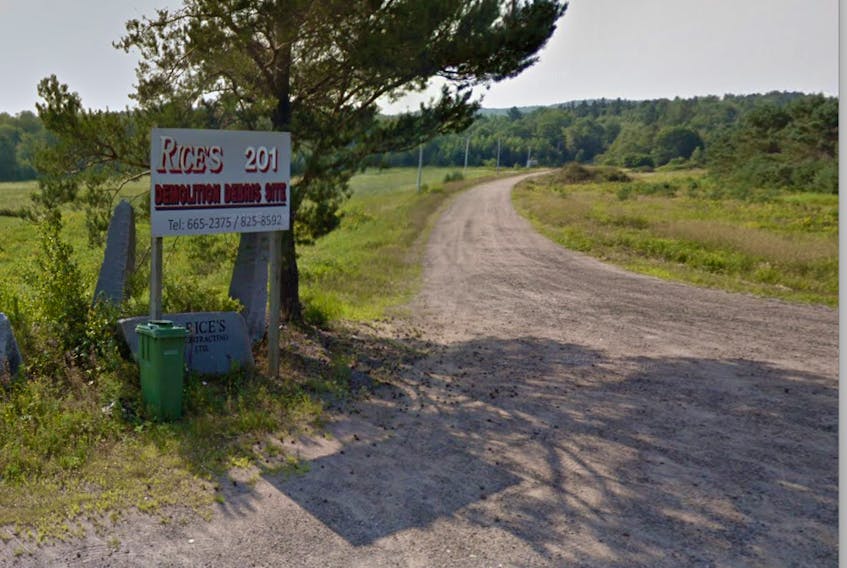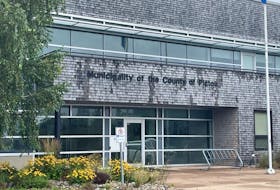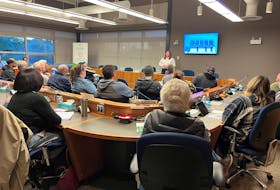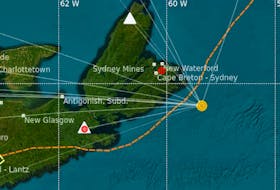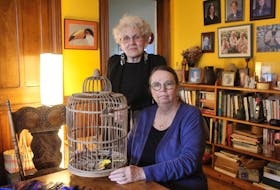KENTVILLE, N.S. — Almost two years after a falling out with Valley Waste, Annapolis County’s garbage may have a new stopping place along its journey by March. According to the municipality’s chief administrative officer (CAO) John Ferguson Jan. 16, a waste transfer station is expected to open in West Paradise at 4736 Highway 201.
Roadside garbage, recycling and compost will be driven to the facility five days a week and, from there, will be transported to the final destinations. Right now, curbside waste has to be driven further to the compost site, recycling facilities or compost facilities.
Only construction and demolition waste will be kept at the site, and the C and D site does not accept asbestos.
In 2019-20, Ferguson says the plan is to open the transfer station to the public five-and-a-half days a week. Including municipal staff at the gate and operation of the transfer site – which the county plans to contract out – there could be up to five jobs created.
As with most waste site decisions, residents in the area – District 7, represented by Warden Timothy Habinski - have expressed concerns. Area residents have been discussing the facility in Facebook groups, letters, presentations, petitions and meetings. Carolyn and David Hubble, who live in nearby Carleton Corner, are the organizers of one Facebook Group: Responsible Management of Waste & Resources in Annapolis County Nova Scotia.
Here are some of residents’ questions the Annapolis Valley Register tried to answer:
What is happening at the site now?
Purchase of land at the site was approved at a special council meeting in September 2019.
Construction and site preparation is now underway on one building at the site, with work at a scale house expected to occur next, Ferguson confirmed. Building permits have been issued by the municipality.
A request for proposals issued by Annapolis in October showed a plan for three buildings on the site. While there were no replies to that tender, contracts have been granted for engineering work, construction of one building – including floor and coverall – and building construction through alternative procurement.
Has the property been approved for a transfer station?
A private construction and demolition disposal site operated on the site for six or seven years, Ferguson said, and before the land was purchased, Rice applied for approval to run a waste transfer station.
According to the municipality’s consolidated financial statements, the Department of Environment approved Rice’s request to operate a transfer station and the permits will be transferred to the municipality.
Jan. 17, an official with the Department of Environment confirmed to the Register by email the permit was still being processed.
“One of the key messages from the citizens is we would expect our county to do above and beyond the requirements, but at least meet the requirements for siting and construction of a waste transfer station as per the Nova Scotia Environment guidelines,” Carolyn Hubble said.
Ferguson says all DOE requirements have been met and studies were done before the land purchase was approved.
“The full requirements from the Department of Environment must be, and were, adhered to. That information will be available at a later date,” he wrote in a Jan. 17 email to the Hubbles, copied to the Register.

What are the water concerns?
Safety of groundwater, surface water and streams, including Button Brook, which is near the property and flows into the Annapolis River, is a worry.
“Most of the floor of the Valley would be fairly clay soil, low-permeable,” David Hubble said.
“But if you go up on the edges of the South Mountain, there are zones that are sand and gravel aquifers and glacial features. This site in West Paradise happens to be… a sand and gravel aquifer.”
He said the geology of the area under the existing transfer station is more suitable.
“There’s not whole lot of leachate that comes off of the garbage from a curbside collection of residential garbage and transfer,” Ferguson said. “There are tanks that are also built as a part of the building and approved by the Department of the Environment. They catch and capture any of the leachate in the actual floor of the transfer facility.
“There’s little - or no - risk to groundwater.
Did a report say Nova Scotia has too many waste facilities?
There are currently 24 transfer stations in the province. While the number of waste disposal facilities - like landfills - is inefficient, according to a report prepared by AECOM for Divert NS, “Efficiency and Effectiveness of the Solid Waste Resource Management System,” best practices support the idea of having transfer stations close to communities.
The report does urge more regional and provincial co-operation on waste policy.
It specifically identifies the breakdown in the inter-municipal services agreement in the Valley region as a cause for concern.
“On-the-ground disputes are putting existing agreements at risk and threaten the success of regional planning and implementation,” it states.
“Standard dispute resolution clauses should be added to the agreements that enable collaborative solutions through discussion, negotiation, and if necessary, mediation. Binding arbitration should be a last resort that is used only in exceptional circumstances.”
Is building a new transfer station a 10-minute drive down the road from an existing one sensible?
David Hubble doesn’t think so.
“To me that flies in the face into showing concern for climate change and carbon emissions.”
Ferguson says the county wanted to use the Lawrencetown transfer station at 349 Elliott Rd, but Valley Waste wouldn’t allow it. Last year, the county lost a court case over expropriating the western management station.
Why does Valley Waste still need a transfer station in Lawrencetown?
Although the county is no longer part of Valley Waste, the towns of Annapolis Royal and Middleton are. Waste from the towns, Bear River First Nation and businesses and residences in the western part of Kings County are still served by the transfer station. In an interview, Andrew Garrett, Valley Waste spokesperson, says approximately 7,500 homes and businesses are still using the site and it is more cost effective for the authority to run two transfer stations than to consolidate operations at the Kentville transfer station. However, the Lawrencetown site is now only open three-and-a-half days a week, instead of five-and-a-half, reducing the need for staff.

How much does it cost?
The overall cost of switching to in-house handling of waste is murky because of the outstanding court cases with Valley Waste. Who owes what to whom after the breakdown of the relationship is a subject of dispute and legal costs are ongoing.
Going forward, costs to Annapolis for a collection and a new waste station would be split across operating and capital budgets, over several years.
“Typically, with big projects like this, no one puts all the costs together on one budget line,” Carolyn Hubble pointed out.
We know that the purchase of land for the transfer station was $500,000 to Rice Construction for one lot – split over seven years of interest-free payments – and a $250,000 charitable tax receipt to Albert and Carol Rice for the appraised value of two other pieces of land. The county’s consolidated financial statements for 2017-18 show that $75,000, plus HST, will be paid to Rice in the first six years with a final payment of $50,000, plus HST, in the seventh year. The county expects to receive a rebate for the HST.

As of Jan. 17, Ferguson said capital costs for the site are just under $700,000.
On the operating side, Ferguson says the municipality will save $4,500 a day by transferring waste on to larger trucks.
What the costs and revenue will be to the public in 2020-21, after the transfer station, is not known, but the CAO said running the existing construction and demolition site is expected to bring in $90,000 annually.
The AECOM report showed Valley region as spending $50 per tonne of waste on transfer station operation and infrastructure. Operating a transfer station is also a significant revenue generator for most of the province’s regions. For example, Valley Waste’s transfer station in Lawrencetown, has an expense line of $356, 817 in the 2019-20 budget and the budgeted revenue is $433,000.
Valley Waste’s budget includes communication, education and enforcement and charging illegal dumpers. Annapolis County is now handling its own enforcement and education by staff and hasn’t increased budgets to counter it, Ferguson said.
Annapolis maintains it can manage waste cheaper on a number of fronts, especially as tipping fees at the landfill in West Hants are half of what they are in than Chester – as well as eight kilometres closer to Annapolis.
“The county is doing everything to make sure that garbage services continue with as little interruption as possible. We’re trying to keep the costs within budget and we anticipate that in the coming years that we may even be able to reduce the budget,” Ferguson said. “We’re working to make this as beneficial to the county as possible.”

Will property values fall?
Several residents have expressed concern about the effect of a garbage facility location on property assessments, which could lead to lower home prices and less property tax revenue for the county.
“No, we don’t see anything that would decrease property values,” Ferguson said. “It has been a C and D site for seven years. Our operations are probably less intrusive. It’s well off the road. It’s not something that you can see
What about truck traffic?
Trucks are expected to run off the Highway 201 on to a service road on their way to the site.
“It’s hard to see any traffic coming up the hill,” David Hubble said. “There’s a bad angle and a bad elevation. If you look to the left, you can’t see cars coming up… and they can’t see you. It’s going to be a dicey spot.”
Area residents have also expressed concerns about safety for pedestrians and cyclists along the route.
Ferguson expects four regular trucks to make two trips to the facility each day, five days a week - 16 trips total. He said there could be two larger trucks leaving each day and the county did not expect spring weight restrictions on the 201 to change that.
In response to residents’ concerns about traffic, he said the municipality will let truck drivers know to slow down and will add signs.
No traffic study has been done at this point, the CAO said.
Why has the county hired New Brunswick lawyers?
When the workload went beyond what the county’s regular solicitor – Bruce Gillis – could manage, Ferguson said the council decided to bring in Gilbert McGloan Gillis (no close relation) of New Brunswick
“A lot of the municipalities have various lawyers in this particular area and we thought it would be good to get the independence,” Ferguson said.

Why are residents surprised?
Because the chosen site isn’t in a zoned area of the county, no public meeting process was required, and some council discussion has happened in-camera (not in an open session) because of the ongoing legal dispute, as well as property negotiations with the Rices.
Ferguson says all financial decisions have been made in open council and a number of media articles have been written, letters sent, and meetings held.
A public information meeting about this particular site didn’t go well - for council or residents – both Ferguson and the Hubbles agreed.
“I am most concerned with the transparency and the decision-making process and the public engagement that leads to good decision making in a democracy,” Carolyn Hubble said, adding she was surprised to learn about the plan in September.
“They’re not quick decisions, some of them may be more expensive decisions, but they’re better decisions and get more public buy-in to the results when you follow a good process. We want to help. We want to see a good outcome for our county. We don’t want this to tear our communities apart, to leave us with a situation where we have a 100 per cent turnover in council next election and no continuity. I mean, those kinds of outcomes are not good for anybody,” she said.
“We feel that citizens have a lot to offer,” Carolyn added, “and, quite often, we neglect our own responsibilities and we don’t pay enough attention to what is going on.”
Wondering what is happening between Annapolis County and its former Valley Waste partners now? Read: What is going on with the Valley Waste dispute?
What questions do you still have about the plan?
Email your Letter to the Editor in response to this article, or any outstanding questions you may have, to [email protected].
Join the conversation. Comments are open on this article for members at SaltWire.com
LEARN MORE
- Municipality of the County of Annapolis - Meeting minutes and agendas and Videos of meetings
- Valley Waste Resource Management
- Nova Scotia Environment waste regulations
- AECOM for Divert NS, “Efficiency and Effectiveness of the Solid Waste Resource Management System"
RELATED COVERAGE
- October 2019: Annapolis County seeks independent, third-party review on Valley Waste issue
- October 2019: Report questions number of landfills in Nova Scotia
- September 2019: Annapolis County calls special meeting to discuss West Paradise transfer site concerns
- August 2019: Valley Waste municipal partners suing Annapolis County
- March 2019: Three jobs lost - Valley Waste’s Lawrencetown transfer station closing two days a week
- December 2018: Valley Waste says RCMP investigation into ‘correspondence’ sent to County of Annapolis concluded
- November 2018: Supreme Court decision says County of Annapolis ‘did not have the authority to expropriate’ Valley Waste transfer station
- November 2018: Valley Waste, County of Annapolis meet in court to talk expropriation
- October 2018: New compost bins rolling out; Annapolis County garbage, recyclables going to Chester
- September 2018: New compost bins ordered for Annapolis County residents
- August 2018: Annapolis County CAO responds to non-payment claims regarding Valley Waste-Resource Management
- August 2018: Annapolis County expropriates Valley Waste’s Lawrencetown transfer station
- August 2018: Valley Waste vows to halt curbside services in Annapolis County Aug. 18
- January 2018: Aylesford man raises questions, concerns about new composting contract

